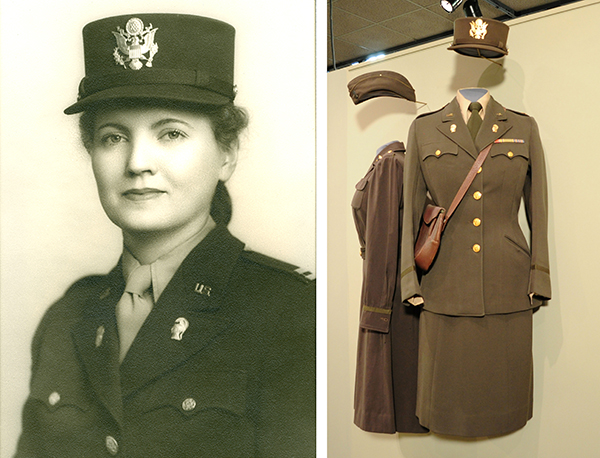
Major Helen Sagl (left) and her uniform (right) in the History Nebraska collections.
The Nebraska History Museum’s collection includes thousands of objects from World War II. Among them are uniforms worn by Helen Sagl while serving in the WAAC/WAC. Sagl was born in Wilber, Nebraska, in 1906, and graduated from high school in Adams. She attended the University of Nebraska, receiving a bachelor’s degree in education in 1930, and a M.A. in educational psychology in 1935. Prior to the war she taught school in Broken Bow, and taught college-level courses in Indiana and Wisconsin. She was living in Lincoln when she enlisted in the Women’s Army Auxiliary Corps (WAAC) in 1942.
Congress approved the creation of a Women’s Army Auxiliary Corps on May 14, 1942, allowing the army to enroll women for non-combatant service. Sagl was one of the first two Nebraskan women inducted into the WAAC on July 8, 1942. On July 20 she and 439 other women entered the first WAAC officers’ training class in Des Moines, Iowa, graduating on August 29.
Sagl served in the WAAC Fourth Company, First Regiment, and was a WAAC battalion commander. Because the WAAC was an “auxiliary,” its members initially had no army status. On July 1, 1943, Congress passed a bill transforming the WAAC into the Women’s Army Corps (WAC). WACs were given regular army status, including army benefits and privileges.
Major Sagl attained that rank before leaving active duty on April 15, 1946. She earned a PhD in education in 1954 and then served on the Indiana University School of Education faculty until her retirement in 1973. She died in 1994 in Albuquerque, New Mexico, at age eighty-seven.

Helen Sagl’s Hobby hat. The hats were named after the first WAAC/WAC director, Oveta Culp Hobby. The standard U.S. Army eagle insignia was used on Hobby Hats after July 1, 1943. History Nebraska 9168-7

WAAC Fourth Company. Helen Sagl is in the front row, third from the right. The WAACs here are wearing an early version of the khaki uniform, which underwent many modifications. The belt, for example, was eliminated from the jacket by October 1942, because it wore out the material beneath it.

Helen Sagl in Dallas, Texas, 1943. A handbag with a shoulder strap was issued to WAACs/WACs to help carry necessities.

WAACs were issued a seersucker exercise dress and matching bloomers. History Nebraska 9168-24

The WAAC/WAC insignia was the Greek goddess Pallas Athene. Officers wore U.S. insignia on their upper lapels, and the Pallas Athene on their lower lapels. History Nebraska 9168-4-C



